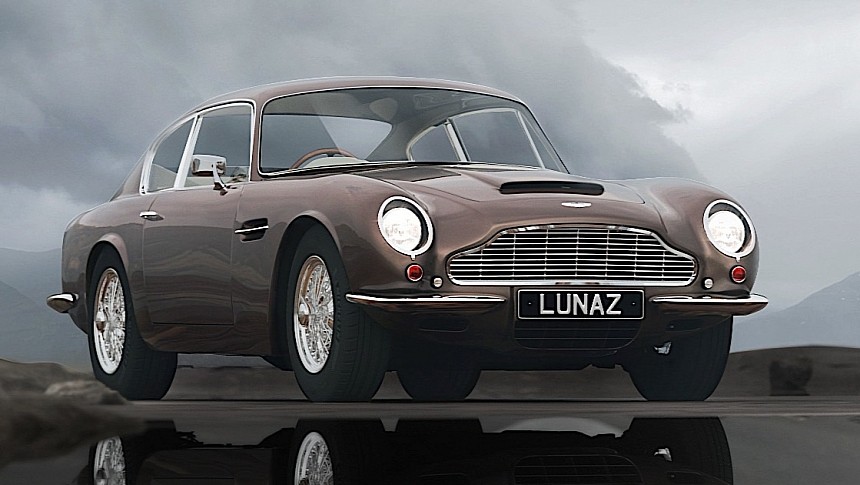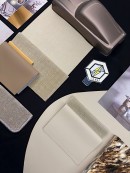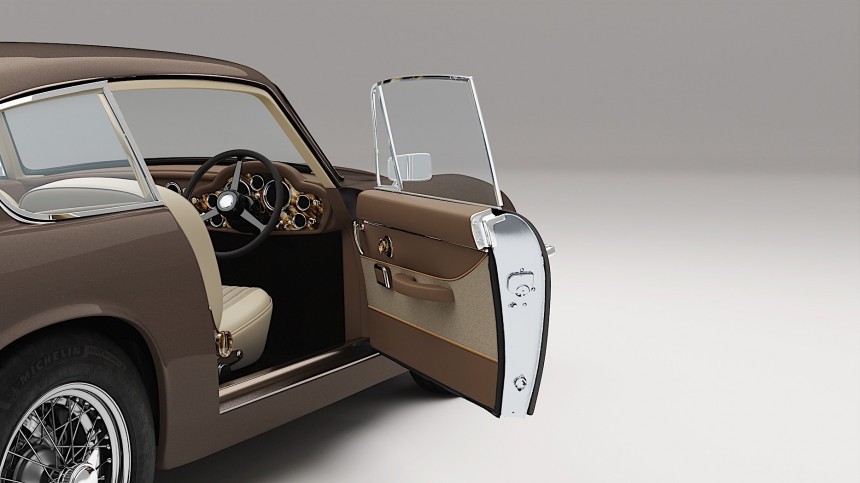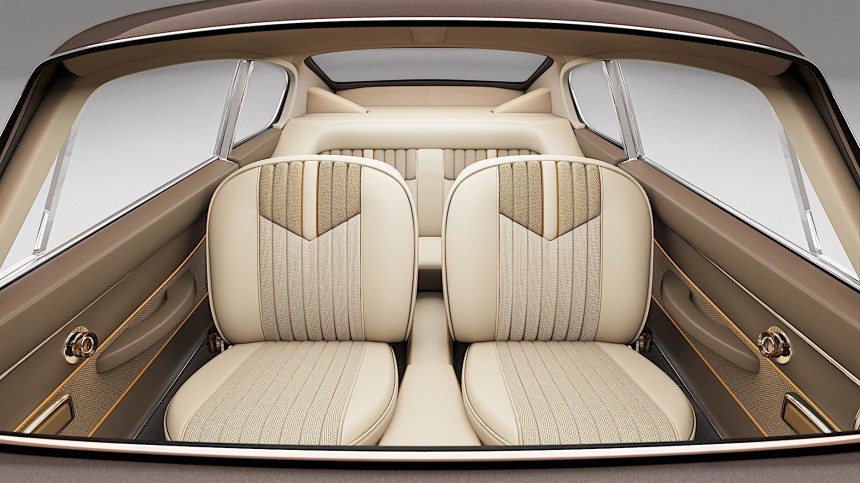The general perception is the main (and at times only) way to make a vehicle eco-friendly is to slap a zero-emissions powertrain into it. But a truly Earth-friendly car does more than that: it incorporates as many natural and sustainable materials as possible. And this Aston Martin DB6 is a testimony of how that can be done.
The DB6 nameplate is no longer around as a new vehicle, but it still makes the headlines thanks to incredible examples that come to light for various reasons. Some belonged to important people, others are somehow relevant for the larger industry, while a few get converted and apparently sacrificed on the altar of electric resto-mods.
Aston Martin originally made the DB6 between 1965 and 1970, during which time just under 1,800 of them rolled off the lines. All were powered by a 4.0-liter straight-six engine that's still a masterpiece of British engineering even to this day.
Despite all that, some people see the powertrain as something that's not particularly desirable in our day and age, so they try to swap it for electric batteries and motors. And by "some people" I mostly mean British company Lunaz.
The name is one of the most important on the EV conversion scene, and focuses on all of the country's main brands, breathing new life into cars wearing the badges of Aston Martin, Bentley, Range Rove, Rolls-Royce, and Jaguar.
Last we heard about this crew was back in September, when the Brits presented a brazen EV conversion of a 1960 Rolls-Royce Silver Cloud II. And not any such car, but the very one owned by Sophia Loren, one of the greatest names of classical Hollywood cinema. The car had been converted for use by Portuguese hotel The Largo, and comes with a price tag of 550,000 pounds ($690,000).
It's a car shown a couple of years ago that is somehow connected to our story today. It was then that Lunaz brought under the spotlight a DB6 that looked just like the original one, but hid an electric powertrain under its metal body. A modern-day conversion of a historically important classic that sold for no less than $1 million.
We have no info on how successful the model has been, or how many of them Lunaz sold, but given that this week a new version of the electric DB6 was presented, chances are it didn't do bad at all.
Just like before, the new Lunaz DB6 uses an electric powertrain. Not just any electric powertrain, but one made in-house by the British builder and comprising "the highest standard European-sourced Tier 1 OEM battery cells and motors."
The exact specifications for the battery used were not announced, but generally speaking Lunaz uses packs with a capacity that goes from 80 to 120 kWh, enough at the highest range of the spectrum to give the car a range of 255 miles (410 km). We do know the electric motors used in converted DB6 cranks out a total of 370 hp.
All of the above is impressive and all, but that's not what makes this particular car special. Lunaz showed it to the world as a design study into how sustainable materials can be used to rebuild a car. The car boasts, as per the company, "eco-conscious material usage never seen combined on a road car."
What does that mean? Well, you'll have to climb inside to get an answer to that question. And you'll also need some explanations, as not all these revolutionary materials are as obvious as you'd think.
Take, for instance, the marble look of the dashboard face, gear shifter, and three-quarter glass handle. That's the usual look of these elements on a DB6, but this time it was achieved by using veneer made from egg and nut shells. Word is this is a stuff so versatile that it can replicate a range of natural high-luxury materials.
Instead of using oil-based plastics, Lunaz deployed elsewhere inside the car corn and wood fibers, and real leather was replaced by a material made using apple and apple cider by-products. The seats and door cards, for instance, contain apple pomace, water-based polyurethane, and wood pulp.
Recycled cotton, polyester, rayon, wool, and nylon, all of them free from what's known in the industry as forever chemicals (substances that can potentially last for thousands of years) are also present in the build.
All of that is hidden by an exterior that remains as classy as you'd expect from an Aston Martin DB6. Although one of them got converted this way, Lunaz says this car is for now only a design study, so not something we're likely to see hit the roads anytime soon.
The materials and techniques used for the car are however production-ready (some of them have already been used on previous Lunaz builds, but never to this extent), and that means if there is public interest in such a car, and the company deems it worthy for production, we might just see more of these eco-friendly-materials-loaded Aston Martins come into focus.
Aston Martin originally made the DB6 between 1965 and 1970, during which time just under 1,800 of them rolled off the lines. All were powered by a 4.0-liter straight-six engine that's still a masterpiece of British engineering even to this day.
Despite all that, some people see the powertrain as something that's not particularly desirable in our day and age, so they try to swap it for electric batteries and motors. And by "some people" I mostly mean British company Lunaz.
The name is one of the most important on the EV conversion scene, and focuses on all of the country's main brands, breathing new life into cars wearing the badges of Aston Martin, Bentley, Range Rove, Rolls-Royce, and Jaguar.
Last we heard about this crew was back in September, when the Brits presented a brazen EV conversion of a 1960 Rolls-Royce Silver Cloud II. And not any such car, but the very one owned by Sophia Loren, one of the greatest names of classical Hollywood cinema. The car had been converted for use by Portuguese hotel The Largo, and comes with a price tag of 550,000 pounds ($690,000).
It's a car shown a couple of years ago that is somehow connected to our story today. It was then that Lunaz brought under the spotlight a DB6 that looked just like the original one, but hid an electric powertrain under its metal body. A modern-day conversion of a historically important classic that sold for no less than $1 million.
Just like before, the new Lunaz DB6 uses an electric powertrain. Not just any electric powertrain, but one made in-house by the British builder and comprising "the highest standard European-sourced Tier 1 OEM battery cells and motors."
The exact specifications for the battery used were not announced, but generally speaking Lunaz uses packs with a capacity that goes from 80 to 120 kWh, enough at the highest range of the spectrum to give the car a range of 255 miles (410 km). We do know the electric motors used in converted DB6 cranks out a total of 370 hp.
All of the above is impressive and all, but that's not what makes this particular car special. Lunaz showed it to the world as a design study into how sustainable materials can be used to rebuild a car. The car boasts, as per the company, "eco-conscious material usage never seen combined on a road car."
What does that mean? Well, you'll have to climb inside to get an answer to that question. And you'll also need some explanations, as not all these revolutionary materials are as obvious as you'd think.
Take, for instance, the marble look of the dashboard face, gear shifter, and three-quarter glass handle. That's the usual look of these elements on a DB6, but this time it was achieved by using veneer made from egg and nut shells. Word is this is a stuff so versatile that it can replicate a range of natural high-luxury materials.
Recycled cotton, polyester, rayon, wool, and nylon, all of them free from what's known in the industry as forever chemicals (substances that can potentially last for thousands of years) are also present in the build.
All of that is hidden by an exterior that remains as classy as you'd expect from an Aston Martin DB6. Although one of them got converted this way, Lunaz says this car is for now only a design study, so not something we're likely to see hit the roads anytime soon.
The materials and techniques used for the car are however production-ready (some of them have already been used on previous Lunaz builds, but never to this extent), and that means if there is public interest in such a car, and the company deems it worthy for production, we might just see more of these eco-friendly-materials-loaded Aston Martins come into focus.








